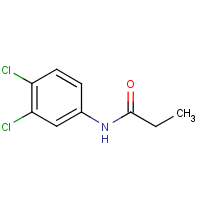Propanil
Agent Name
Propanil
CAS Number
709-98-8
Formula
C9-H9-Cl2-N-O
Major Category
Pesticides

Synonyms
3',4'-Dichlorophenylpropionanilide; 3,4-Dichloranilid kyseliny propionove [Czech]; 3,4-Dichloropropionanilide; B-30,130; BAY 30130; Bayer 30 130; Cekupropanil; Chem Rice; Chem-Rice; Crystal propanil-4; DCPA; Dichloropropionanilide; Dipram; Drexel Prop-Job; Erban; Erbanil; FW 734; Farmco propanil; Grascide; Herbax; Herbax 3E; Herbax 4E; Herbax LV-30; Herbax technical; Montrose propanil; N-(3,4-Dichlorophenyl)propanamide; N-(3,4-Dichlorophenyl)propionamide; Prop Job; Prop-Job; Propanamide, N-(3,4-dichlorophenyl)-; Propanex; Propanid; Propanide; Propanilo; Propionanilide, 3',4'-dichloro-; Propionic acid 3,4-dichloroanilide; Propionic acid-3,4-dichloroanilide; Riselect; Rogue; Rosanil; S 10165; S10165; Stam; Stam 80EDF; Stam F 34; Stam LV 10; Stam M-4; Stam supernox; Stampede; Stampede 360; Stampede 3E; Strel; Supernox; Surcopur; Synpran N; Vertac Propanil 3; Vertac Propanil 4; Wham EZ; [ChemIDplus]
Category
Herbicides, Anilide
Description
White solid; [Merck Index] Colorless, white, or light brown odorless solid; [HSDB] Medium to dark grey solid; Formulated as emulsifiable, soluble, and flowable concentrate liquids and as water dispersible granules; [Reference #2]
Sources/Uses
A post-emergence herbicide used to control weeds in rice, potatoes, and wheat; [EXTOXNET] Used as post-emergence herbicide for rice; Also registered, but not marketed, for use on commercial sod farms; [Reference #2]
Comments
Skin and respiratory irritant; [EPA Pesticides, p. 119] May be contaminated by chemicals that can induce chloracne. [Rosenstock, p. 714] Chloracne and methemoglobinemia reported in a study of workers in a pesticide plant producing propanil; [HSDB] The following herbicides have an oral LD50 of >1 gm/kg and have little or no acute toxicity in humans: Alachlor, Amitrole, Ammonium sulfamate, Atrazine, Dalapon, Dicamba, Glyphosphate, Monuron, Oryzalin, Picloram, Propanil, Simazine, etc. [LaDou, p. 613] Short-term exposure may affect the nervous system and blood leading to formation of methemoglobin; [ICSC]
Restricted
Uses on small grains voluntarily cancelled; [Reference #2]
Reference Link #1
Biomedical References
Exposure Assessment
Bioaccumulates
Yes
Vapor Pressure
9.08E-07 mm Hg
Lethal Concentration
LC50 (rat) > 6,100 mg/m3/4hr
Reference Link #2
Adverse Effects
Methemoglobinemia
MetHgb is secondary toxic effect
Dermatotoxin
Chloracne
Diseases, Processes, and Activities Linked to This Agent
Diseases
Occupational diseases associated with exposure to this agent:
Processes
Industrial Processes with risk of exposure: